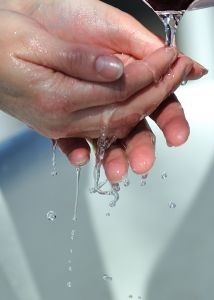 I’m terrified of food borne illnesses and rightly so. E. coli, salmonella and hepatitis are only a few of the diseases that can be contracted from food that is improperly prepared. I’ve compiled the following tips for safe food handling from the CDC, USDA and FDA websites.
I’m terrified of food borne illnesses and rightly so. E. coli, salmonella and hepatitis are only a few of the diseases that can be contracted from food that is improperly prepared. I’ve compiled the following tips for safe food handling from the CDC, USDA and FDA websites.
When you prepare:
- Wash your hands thoroughly before and after handling food. Also be sure you wash your hands when switching from meat to produce.
- Freezing meat (raw or cooked) is perfectly fine but be sure to thaw it properly. Plan ahead so that it can be thawed slowly in the refrigerator, as opposed to on the counter at room temperature.
- As a general rule, rinse all fresh produce.
- Do not rinse your chicken. Rinsing chicken is unnecessary and only spreads bacteria from the raw meat to your sink where it so easily travels to other areas.
When cooking:
- Designate a special cutting board for meat. Never use your ‘meat board’ for produce or bread. Also, avoid using cutting boards that have porous surfaces or deep cuts that present themselves over time.
- Don’t cross-contaminate by using implements (such as a spatula or knife) for meat and other foods. Keep track of which utensils you are using for each type of ingredient and don’t mix them up.
- Not everyone likes their steak well-done. I get that. It’s still very important that you let all food reach the proper temperature. Visit the USDA’s website, Is it Done Yet? for a detailed description. You can also call the USDA Meat and Poultry Hotline at 1(888)MPHotline.
When cleaning and storing:
- Make sure that your appliances are working properly and that they are set at reasonable temperatures. Your refrigerator should be at least as cold as 40 degrees Fahrenheit and your freezer should reach zero degrees Fahrenheit.
- Refrigerate leftovers promptly and in shallow containers so that they cool down quickly. This goes for all leftovers, not just meat.
- If you use sponges, replace them often. Microwaving and bleaching a sponge will not kill all of the bacteria it accumulates. Never use a sponge to clean up after raw meat. If you do, discard it immediately and open a new one.
- Properly clean all surfaces (including the sink!) and cooking implements with hot, soapy water. I like to use Clorox wipes after preparing any type of raw meat.
- Don’t neglect buttons, handles and knobs on kitchen appliances when you’re cleaning.
Can you think of any others that I missed?
Also Read:
Food Safety 101: Stay Healthy this Holiday Season
